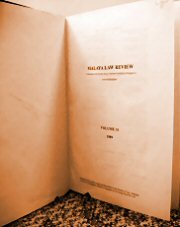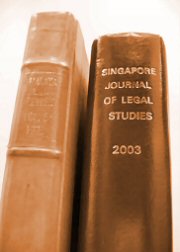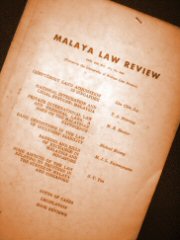|
Archive |
2386 records match your query:
| 361. | JULY 2011 Issue | p.212 | |
| | Sedition and its New Clothes in Singapore
Tan Yock Lin • [2011] Sing JLS 212 (Jul)In all the important common lawjurisdictions surveyed here, seditious libel means defiance or censure of constituted authority leading to foreseeable harm to public order. In sharp contrast, the Sedition Act in Singapore, it was recently decided, makes allegations of censure of constituted authority and foreseeable harm to public order unnecessary, with the result that the offence, created by s. 3(1)(e) read with s. 4 of the Sedition Act, is transformed into a hybrid offence of blasphemous libel wider than the offence of blasphemous libel against a group of persons created by s. 153A of the Indian Penal Code, 1860 and the common law offence of blasphemous libel. This article argues that the decision cannot be defended and that furthermore, where the constitutional freedom of expression of a citizen is implicated, the Singapore Constitution would require the Sedition Act to be modified in order to differentiate between class divisive publications that threaten public order and those that do not.
| | 362. | JULY 2011 Issue | p.298 | |
| | Book Review: Private Security, Public Order: The Outsourcing of Public Services and Its Limits by Simon Chesterman and Angelina Fisher, eds.
Cheah Wui Ling • [2011] Sing JLS 298 (Jul)Much of the public debate about the use of private military and security companies ("PMSCs") has focused on PMSCs as a separate and independent phenomenon. This excellent compilation edited by Simon Chesterman and Angelina Fisher, Private Security, Public Order, adds much breadth and nuance to this debate by bringing together a group of scholars who analyse the topic of PMSCs through different theoretical frameworks, disciplinary perspectives and comparative case studies.
| | 363. | JULY 2011 Issue | p.301 | |
| | Book Review: The Presumption of Innocence: Evidential and Human Rights Perspectives by Andrew Stumer
Ho Hock Lai • [2011] Sing JLS 301 (Jul)The presumption of innocence is widely celebrated. In Singapore, it has been hailed by V. K. Rajah J.A. as "the cornerstone of the criminal justice system and the bedrock of the law of evidence" (see XP v. PP [2008] 4 S.L.R.(R.) 686 (H.C.) at para. 90). But what exactly is the presumption of innocence?
| | 364. | JULY 2011 Issue | p.304 | |
| | Book Review: The Goals of Private Law by Andrew Robertson and Tang Hang Wu, eds.
Karin Lai Yiling • [2011] Sing JLS 304 (Jul)The origins of this book lie in the Fourth Biennial Conference on the Law of Obligations, hosted for the first time by the National University of Singapore in July 2008. Out of the sixty-eight papers presented at the conference, nineteen were ultimately assembled and presented in this collection of essays about The Goals of Private Law.
| | 365. | DECEMBER 2010 Issue | p.227 | |
| | Malaysia - Death of a Separate Constitutional Judicial Power
Richard S.K. Foo • [2010] Sing JLS 227 (Dec)This article examines the position of the separation of powers doctrine within the Federal Constitution of Malaysia and in particular, the position of "the judicial power of the Federation" before and after the 1988 constitutional amendment to Article 121. Through textual analysis and a review of the extant case law, conclusions are offered regarding the manner in which the separation doctrine is incorporated within the Constitution and whether its principles may apply with implicit constitutional force, the efficacy of the 1988 amendment to effect substantive constitutional change, and whether "the judicial power of the Federation" remains exclusively vested in the courts established under Article 121. The Federal Court's decision in Public Prosecutor v. Kok Wah Kuan [2008] 1 M.L.J. 1 is discussed.
| | 366. | DECEMBER 2010 Issue | p.256 | |
| | Reynolds Privilege, Common Law Defamation and Malaysia
Andrew T. Kenyon and Ang Hean Leng • [2010] Sing JLS 256 (Dec)The defence of qualified privilege has developed in the defamation law of many countries that share English legal heritage. Malaysian cases have applied, in particular, English or Australian developments in qualified privilege. However, Malaysian judgments have not engaged in a close analysis of how the foreign changes arise under Malaysian law. This article explains how the Australian developments appear difficult to apply within the Malaysian context, while the English developments offer a clear avenue for Malaysian defamation law's modernisation. The key reason for this is the way in which the English Reynolds privilege can be seen to have its origins, at least in part, within the common law as well as within European human rights standards. The common law aspects of Reynolds, apparent from a wide range of English judicial statements, offer a doctrinal basis for the existing and future application of the Reynolds defence in Malaysian defamation law.
[Full Text]
| | 367. | DECEMBER 2010 Issue | p.282 | |
| | Sudden Fight, Consent and the Principle of Comparative Responsibility in the Indian Penal Code
Ian Leader-Elliott • [2010] Sing JLS 282 (Dec)Sudden fight is one of four partial defences to murder in the Indian Penal Code. It was a late addition which lacks the qualifying provisos and illustrations that constrain applications of the partial defences of provocation and excessive force in private defence. A survey of recent decisions of the Indian Supreme Court suggests that sudden fight has the potential to subvert the principled limits that constrain the other partial defences. Sudden fight has no equivalent in other Commonwealth jurisdictions. It can be argued that it is an anachronism that should be eliminated from the law of murder. This essay argues in favour of its retention. The partial defences of provocation, excessive defence, sudden fight and consent are unified by an underlying principle of comparative responsibility that extenuates murder when the offender was seriously wronged by the victim or acted with the consent of the victim to die or engage in an activity that was likely to result in death. A set of provisos and illustrations is proposed that will constrain applications of the partial defence of sudden fight in conformity with the principle of comparative responsibility.
| | 368. | DECEMBER 2010 Issue | p.304 | |
| | Virtual World, Virtual Land but Real Property
Hannah Yee Fen Lim • [2010] Sing JLS 304 (Dec)Virtual worlds such as Second Life have become increasingly significant in terms of both time and money for their users. As such, it is important to analyse how the law may apply to and resolve disputes that originate in these virtual worlds. This article will focus on the virtual world Second Life, and in particular, the legal concept of land in Second Life which has come into the international legal limelight because of the Bragg litigation against Linden in the United States. Although the dispute was settled, the Bragg litigation raised the issue of the legal status of items in virtual worlds and whether these virtual items can indeed be recognised as property under the Western legal tradition. This is an issue separate from and independent of the question of intellectual property protection. This article will argue that land ownership in Second Life is very much like owning a modified form of leasehold property. Just like in the real world where more than one type of property right can subsist in a given item, this should also be the case in Second Life.
[Full Text]
| | 369. | DECEMBER 2010 Issue | p.328 | |
| | Full Contractual Capacity: Use of Age for Conferment of Capacity
Loo Wee Ling • [2010] Sing JLS 328 (Dec)The Singapore Civil Law (Amendment) Act, effective 1 March 2009, lowered the age of full contractual capacity from 21 to 18 with the sole aim of encouraging entrepreneurship among the young. This article examines if currently available scientific evidence and practical considerations indicate: (i) whether there is utility in using an age-based criterion for conferring full contractual capacity and thus denying legal protection in contracting in light of the need to balance protection of minors in contracting against encouraging youthful entrepreneurship; (ii) even if useful, whether full contractual capacity should be conferred from age 18 in the Singapore context; and (iii) if extra measures ought to have accompanied the lowering of the age of full contractual capacity to mitigate potential problems affecting consumer-minors and entrepreneur-minors who are now deprived of previously available legal protection under contract law.
| | 370. | DECEMBER 2010 Issue | p.352 | |
| | The Amicus Curiae: Friends No More?
S. Chandra Mohan • [2010] Sing JLS 352 (Dec)A term commonly used in both common law and civil law jurisdictions and in domestic and international tribunals is the Latin term amicus curiae or a 'friend of the court'. Who is this friend of the court and what is his role in legal proceedings? Largely because of the remarkable manner in which this ancient institution has developed in different legal systems and been used differently even in countries sharing a common legal tradition, such as the United States and the Commonwealth countries, the important question is whether the amicus curiae can still be considered a 'friend' of any tribunal or decision maker. Has this friendship been well maintained or significantly abused over the years?
| |
|
|


 |







